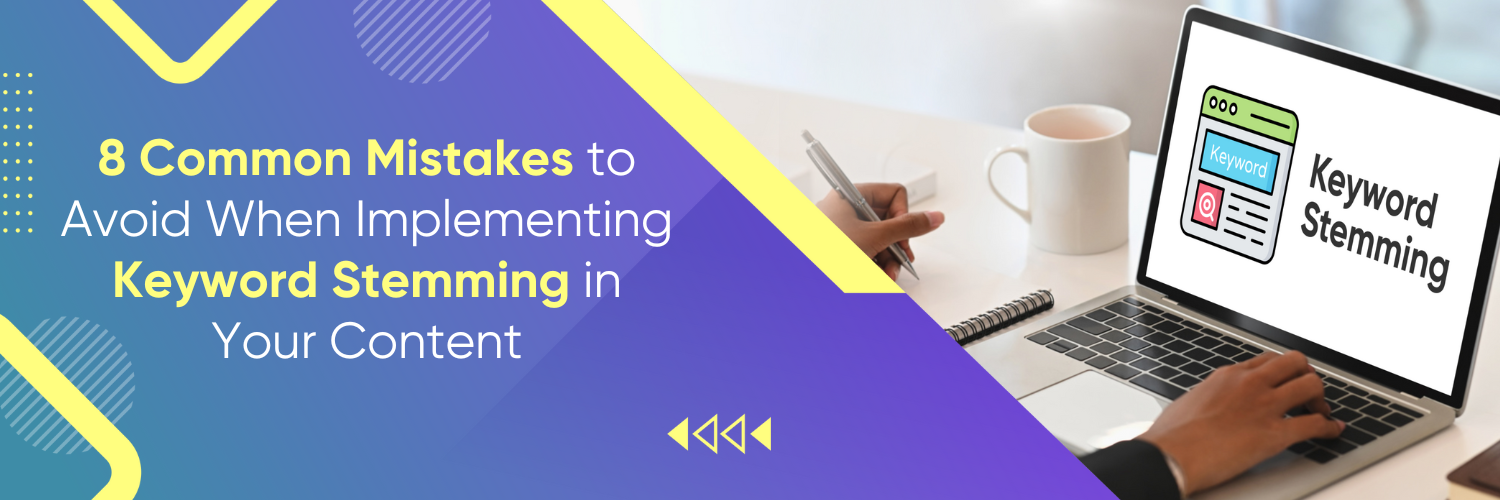What is Keyword Stemming?
Keyword stemming is the process of using a root word to find different variations. For instance, from the word “marketing,” stemming can derive “marketer” and “marketable.” This enables SEO professionals to target a wider range of keywords without resorting to keyword stuffing, thus enhancing content relevancy and visibility.
The 8 Common Mistakes to Avoid
Mistake 1: Over-Stemming Keywords
Over-stemming occurs when the stemming process generates words that stray from the intended meaning. For example, “universal” stemming to “universe.” This mistake can hurt your SEO by producing irrelevant content. Tools like Porter’s stemming algorithm can sometimes cause this problem, so manual reviews are necessary.
Mistake 2: Under-Stemming Keywords
Under-stemming means missing potential variations of a keyword. Failing to include these variations might result in reduced visibility. Employing a combination of automated tools and manual oversight can help prevent this error.
Mistake 3: Ignoring Relevancy of Stemmed Keywords
Not all stemmed keywords are relevant to your content, and using unrelated keywords can harm your ranking. Ensure that the stemmed keywords fit the context and overall message of your content.
Mistake 4: Lack of Consistency Across Content
Inconsistent use of stemmed keywords across your website can confuse both readers and search engines. Develop a uniform approach to keyword stemming and apply it consistently to maintain coherence.
Mistake 5: Neglecting Negative Keywords
Avoid stemming towards negative or undesirable keywords, which can attract irrelevant traffic. Tools like Google Ads allow you to set negative keywords to prevent these mismatches.
Mistake 6: Relying Solely on Automated Stemming Tools
Automated tools can make mistakes, so don’t solely rely on them. A hybrid approach, combining automated tools with human judgment, can ensure accuracy and relevance.
Mistake 7: Failing to Monitor Keyword Performance
Constant monitoring of keyword performance is essential. Regularly review your analytics to identify and adjust any stemming mistakes, ensuring ongoing optimization.
Mistake 8: Ignoring the Context of Stemmed Keywords
Always consider the context in which a keyword is used. Stemming algorithms may not always understand subtleties, so human oversight is vital to ensure contextual accuracy.
Need help with your SEO strategies? Click to Get Started.
Tips for Effective Keyword Stemming
Effective keyword stemming can enhance your SEO strategy, but it requires a thoughtful approach to deliver optimal results. Here are some practical tips to guide you:
- Prioritize Quality Over Quantity: Instead of cramming your content with numerous stemmed keywords, focus on including those that enhance the quality and relevance of your content.
- Integrate Naturally: Stemmed keywords should fit seamlessly into your content. Readers shouldn’t feel that keywords are forced or out of place.
- Leverage LSI (Latent Semantic Indexing) Keywords: Along with stemmed versions, consider using LSI keywords, which are semantically related terms. This can make your content richer and more contextually relevant.
- Keep Content Purpose in Mind: The ultimate goal is to provide valuable content to your readers. Ensure that stemmed keywords don’t detract from the main message or theme of your content.
- Cross-reference with Competitors: Check how competitors in your niche are using keyword stemming. This can provide insights into potential keyword opportunities or gaps in your strategy.
- Avoid Extreme Variations: Some stemmed variations might be too far removed from the primary keyword and could confuse search engines and readers. Stick to relevant and closely related stems.
- Combine with Keyword Modifiers: Use modifiers like “best,” “top,” “how to,” with your stemmed keywords to create long-tail keyword opportunities that can drive more specific and qualified traffic.
- Regularly Audit Your Content: Periodically review your content to identify opportunities to incorporate relevant stemmed keywords or remove those that no longer fit.
Conclusion
Keyword stemming, when used judiciously, can amplify the reach and relevancy of your digital content, giving your brand an edge in the competitive online landscape. By internalizing the insights from the eight common mistakes and adhering to best practices, you’re already a step ahead in your SEO journey. Yet, mastering SEO requires continuous learning, adaptation, and expertise. If you’re ready to elevate your business to new heights and ensure sustained digital success, it’s time to consider professional assistance.
Partner with Ubique Digital Solutions, where our dedication meets your ambition. Together, we’ll chart a course for your business’s triumphant digital voyage. Follow and partner with us today!
FAQs
Q: How can I identify if I’m over-stemming or under-stemming keywords?
Regularly review your content and analytics, and use a combination of tools and human insight to identify and correct any mistakes.
Q: Are there any tools that make keyword stemming easier?
Yes, tools like Google’s Keyword Planner, Moz’s Keyword Explorer, and Python libraries like NLTK can assist in keyword stemming.
Q: How often should I review and update my keyword stemming strategies?
Regular monitoring and updating are vital for maintaining an effective keyword stemming strategy, so periodic reviews and adjustments are recommended.










